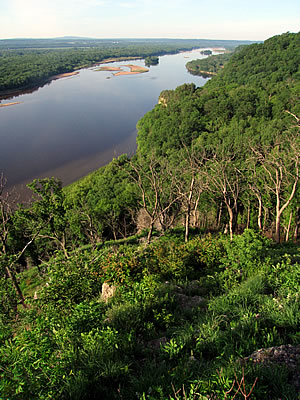Site Description
This IBA, encompassing most of the Lower Wisconsin State Riverway as well as the Spring Green Preserve owned by The Nature Conservancy, presents a vast mosaic of lowland and upland habitats associated with a large-river floodplain. Present are river islands ranging in cover from open to forested; floodplain and upland (oak and maple-basswood) forest tracts, some extensive; wet prairie; sedge meadow; emergent marsh, both shallow and deep; managed impoundments; shrub swamp; oak barrens; dry prairie; sandy oldfields; and bluffs.
Ornithological Importance
The Lower Wisconsin River contains habitat for a wide variety of priority species and is considered especially critical for southern forest birds. It contains some of southern Wisconsin’s largest populations of red-shouldered hawk, prothonotary warbler, and cerulean warbler, as well as yellow-crowned night-heron, American woodcock, whip-poor-will, yellow-billed cuckoo, Acadian flycatcher, Eastern wood-pewee, wood thrush, Kentucky warbler, and hooded warbler. Dry prairies and more open barrens provide important habitat for grassland birds that prefer shorter, sparser vegetation, notably lark sparrow but also grasshopper sparrow and Western meadowlark. Barrens and shrub habitats support brown thrasher, Bell’s vireo, field sparrow, vesper sparrow, and orchard oriole. Least bittern, willow flycatcher, marsh wren, sedge wren, and swamp sparrow breed in wetlands and shrub swamps. The IBA also provides critical habitat for staging and migrating birds including waterfowl, waterbirds, landbirds and raptors, and sandhill cranes. Large numbers of bald eagles, waterfowl, and gulls use the river in winter, often congregating below the Prairie du Sac dam when the river freezes elsewhere, and numerous wooded bluffs along the river provide important roosting habitat for wintering eagles.
Read more about conservation planningfor the Lower Wisconsin River IBA.

Lower Wisconsin River, photo by Mike Mossman